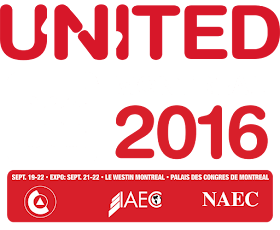I had the opportunity to attend the 2016 NAEC United
Convention. It was a great event. Every four years there is a United Convention
which brings together the US and Canadian trades groups, NAEC and CECA. This year the IAEC[consultants] where a
partner in the convention. This is a
good way for contractors, suppliers and consultants to get together and share
experiences, ideas, learn and see what is new on the market.
Monday – We had a presentation on new technology form 8
different suppliers. The two big items I
took away was CEDES selling a new 3D scan device which will come out in 3
different phases which if it is what they say it is will be the only 3D scan
that works well. The other item was a
non-heat producing push button lamp[led] replacement for some of the popular
fixtures, no bleed through, no heat which are guaranteed for life from Mathis
Electronics. http://www.mathiselectronics.com.
Tuesday – We had a key note address by Brian Holloway, AFC
winning 85’ Patriots. He was great and
motivating and he did touch on the 85’ Bears.
We had our general business session and then our contractor
session. The hot topic in the contractor
session was the MCP. MEI gave a
modernization start to finish presentation for efficiencies and best practices
and Dick Gregory gave a talk about A17.1 which touched on OEO and MCP.
Wednesday – The show started which had a ton of suppliers
showing their elevator equipment and new products. There was also education sessions going on
all day. I attended Maxtons electronic valve
presentation and another MCP informational session with John Koshak. There was a opportunity for NAEC’s under 40
people, called NexGen, to get together for lunch. During the evening there was a great dinner
with Cirque performers.
Thursday – Final day of the trade show. I got to attend a group that gets together
called Bridge Builders which included NAEC, CECA, Elevator U, Elevator World,
EESF, NAESA, ASME, NEII and groups from China, Japan & Argentina.
It was a busy week going around the show from here to
there but as much as I am ready to leave at the end of it, I get excited about
elevators and getting back to work with the knowledge I got from the
convention. I saw countless good friends
and business relationships and met more this trip. The connections you can make in a reception,
on the show floor, at an education session, at breakfast, at dinner, at a after
party are invaluable.
Next year’s NAEC convention is in Orlando Florida.
If
you have any questions or would like information from Colley Elevator you can
go to www.colleyelevator.com, email Craigz@colleyelevator.com or call 630-766-7230.



 Platform lifts must meet the ASME A18.1 Safety Standard for Platform Lifts and Stairway Chairlifts. The ASME A18.1 covers the design, construction, installation, operation, inspection, testing, maintenance and repair of lifts that are intended for transportation of persons with disabilities. However, use of a later edition of the ASME A18.1 may provide equivalent or greater accessibility. Questions about the ASME A18.1 code should be directed to the American Society of Mechanical Engineers (
Platform lifts must meet the ASME A18.1 Safety Standard for Platform Lifts and Stairway Chairlifts. The ASME A18.1 covers the design, construction, installation, operation, inspection, testing, maintenance and repair of lifts that are intended for transportation of persons with disabilities. However, use of a later edition of the ASME A18.1 may provide equivalent or greater accessibility. Questions about the ASME A18.1 code should be directed to the American Society of Mechanical Engineers (
